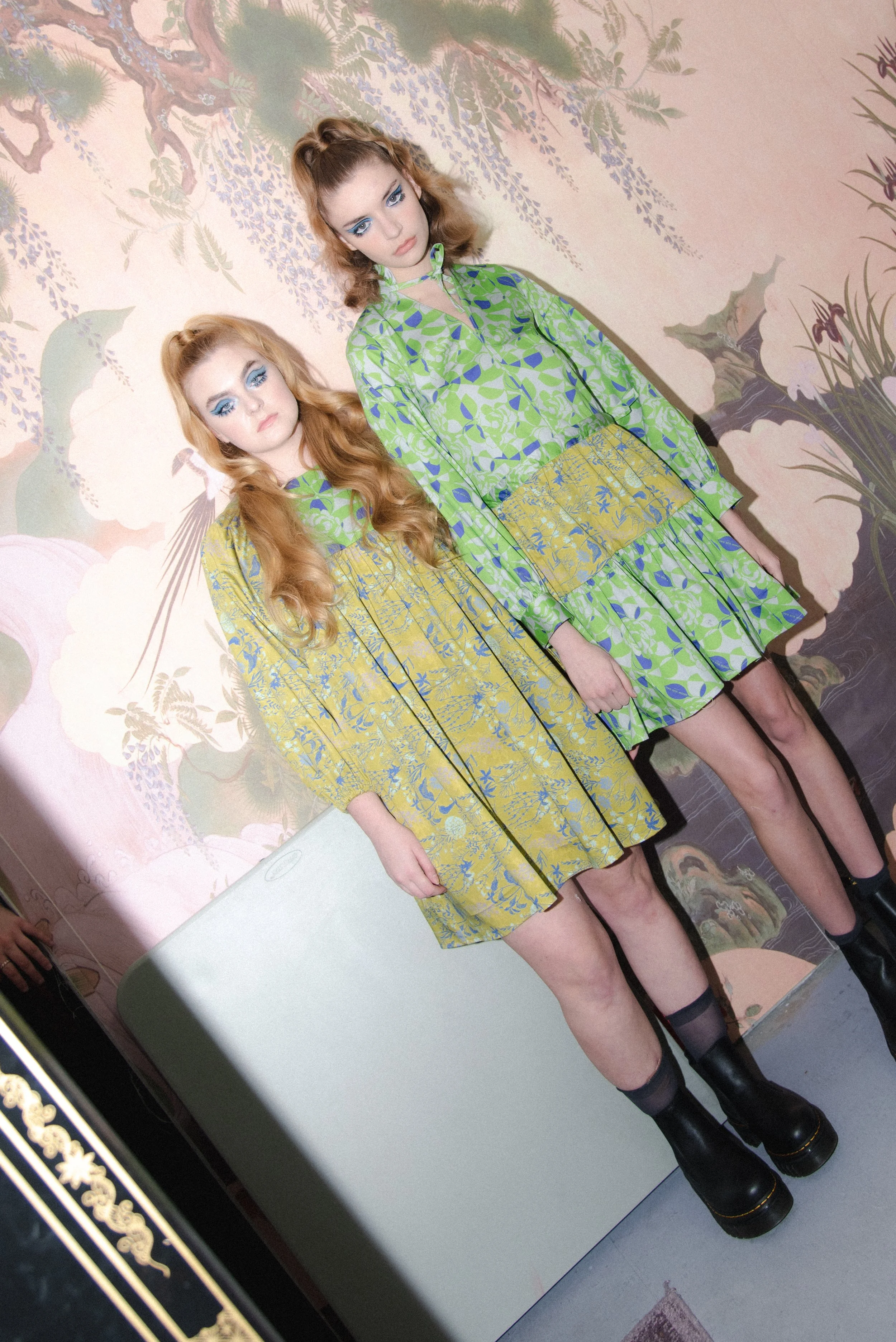Snow Xue Gao Fall/Winter 2023 Collection Packs a Flower Power Punch
photographed by Sravya Balasa and Kate Hada, written by Yoko Zhu
Womenswear designer Snow Xue Gao showcased her fall/winter collection in her Bowery storefront during New York Fashion Week. The presentation was a seven-minute walk from the subway station. I joined the growing line of youthful, chic faces outside the flagship store. Vibrant colors, purposeful silhouettes, and statement fur coats brightened the street. Passerbys—people on their way to work—shared the sidewalk with the NYFW attendees. Most ignored the commotion, quickly cutting through the city with a pre-planned destination in mind, oblivious to our anticipation.
Many attendees took out their phones, quick to photograph themselves. There was the occasional small talk–polite compliments and what-do-you-dos. Eventually, I found myself interviewing the girl in front of me.
Pranathi Kamineni–my line neighbor and intern for Global Fashion Collective (an organization that aims to propel established and new designers)–shared with me that she hated fashion for the longest time.
“I felt like I couldn’t dress my body,” Kamineni said. “But then I found what I like to wear. It made fashion feel more comfortable and a safe place. I think fashion’s not defined by the clothes, but defined by the person wearing them.”
There was a prevailing sentiment that fashion was embracing inner individuality. I considered my own outfit, which by no means, was elaborate. I’d cobbled together my thrifted clothes and my godmother’s fur jacket. Conventionally, it wasn’t beautiful, but I was comfortable in the clothes that I’d worn. I liked that enough.
Eventually, we trickled into the store. The fresh swarm of craning necks, cell phones, cameras, and energetic conversations permeated through the room. Clothing racks lined the side. The hangers were separated three fingers apart; meticulous detail was applied to every rack.
Snow’s womenswear collection was adorned with her signature floral prints and eye-catching leaf patterns. The presentation consisted of thirteen fashion models—sporting Snow’s flamboyant designs—radiating composure. The eye makeup was turquoise and Twiggy, consisting of false lashes on both the bottom and top lash lines. The hair was styled into soft, swooping waves. Some of the looks sported blazars. Celebrity dogs Tinkerbelle and Belle sat on the models’ laps. Next to them, stood a board featuring designer Snow Xue Gao’s inspiration and aesthetic: the sixties.
The busy Snow Xue Gao stated that the board included research on classic sixties silhouettes and shapes. “[The collection is] inspired by the Woman’s Power Movement,” Snow said when interviewed for Rice & Spice Magazine. “I think it’s very interesting how a woman can be angry and protest on the streets.”
Notably, Snow channeled that inspiration—the outspoken woman—into flower power. The flower motifs were feminine, loud, and impossible to ignore. Snow's clothes were undeniably modern, and yet, I felt there was a sense of faraway, foreign dreaminess imbued in the patterns. The sixties were a period of discovery. Women were demanding rights (and still are). The era was an explosion of colors, breaking fast the monotone binary. And in the storefront, I felt the spirit resurge. There were so many people seeking and exploring expression through fashion. Several of Snow Xue Gao’s guests included upcoming designers and influencers.
Wearing a beige blazer, digital creator Bella Nguyen said she took inspiration from Gao’s layering and symmetry. She expressed excitement about attending her first NYFW show, especially as someone who loved fashion since childhood.
“I used to design when I was a kid, but somehow it didn’t work out. Now I’m trying to get back into fashion, not as a designer, but as a content creator trying to inspire people as much as I can,” said Nguyen.
The majority-female guests seized the opportunity to photograph themselves, especially in front of the neon-lit Snow Xue Gao sign. There was ample seltzer (courtesy of Asian American brand Lunar), with a range of flavors like lychee, yuzu, and passionfruit for those who wanted a light buzz. The dialogues began to overlap; the voices sounded like a collective hum. As bodies began to mingle, the space transformed into a social scene. Everyone was someone–not necessarily famous–but appeared dedicated to their ambitions. Whether it was media or art, they spoke enthusiastically. The dedication to breaking the mold was like a palpable force inside the small Bowery store. In a way, it felt like the sixties had swung by.
Designer Snow Xue Gao petting Tinkerbelle and Belle The Dog photographed by Sravya Balasa
@swunicorn photographed by Sravya Balasa
Fashion content creator Rini Jain photographed by Sravya Balasa
Fashion designer Evan Hirsch photographed by Sravya Balasa
Fashion, lifestyle, and travel influencer and music artist Ruth Raia photographed by Sravya Balasa
Guests photographed by Sravya Balasa
Guests photographed by Sravya Balasa
Stylist Alicia Liu photographed by Sravya Balasa
Style influencer Hannah Qin photographed by Sravya Balasa
Hannah Qin with guest Leni Morgenbesser photographed by Sravya Balasa
Brand designer and stylist @nisboa photographed by Sravya Balasa
Lunar Event & Marketing Coordinator Vivian Zhou photographed by Sravya Balasa
Snow Xue Gao with a guest photographed by Sravya Balasa
Rice & Spice Managing Editor Yoko Zhu photographed by Sravya Balasa
Rice & Spice Events Coordinator Kate Hada photographed by Sravya Balasa


















































































